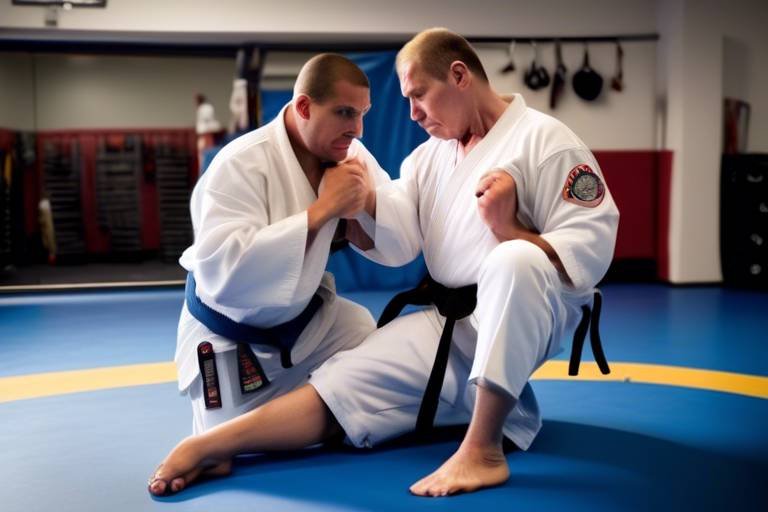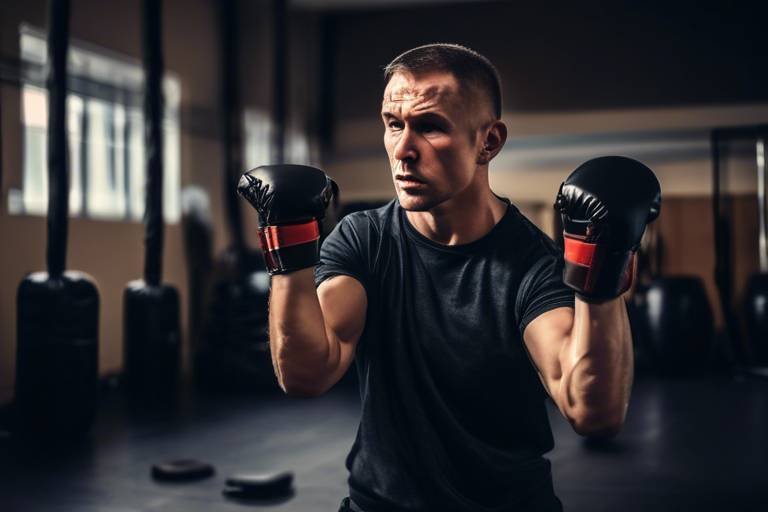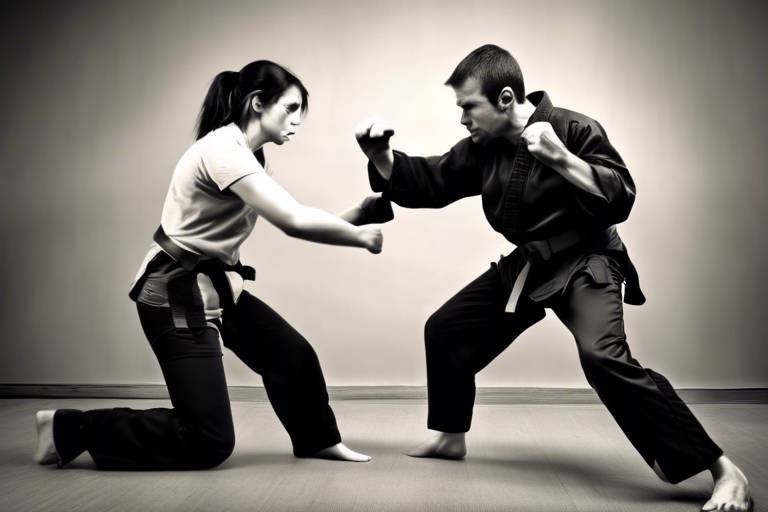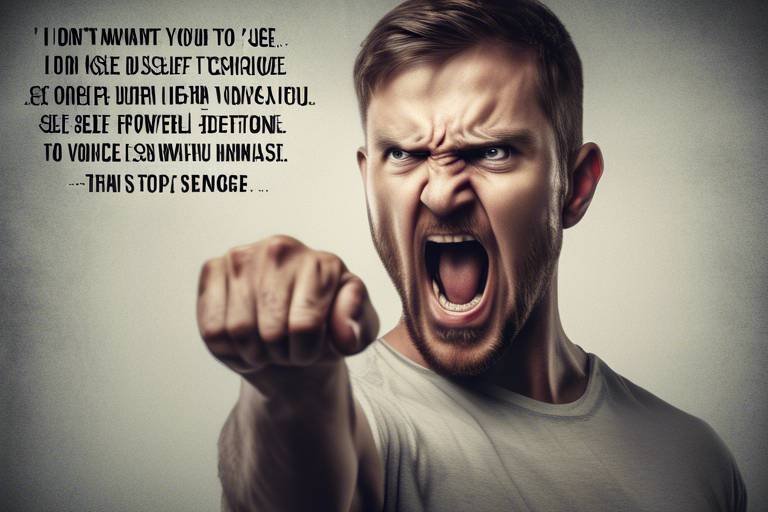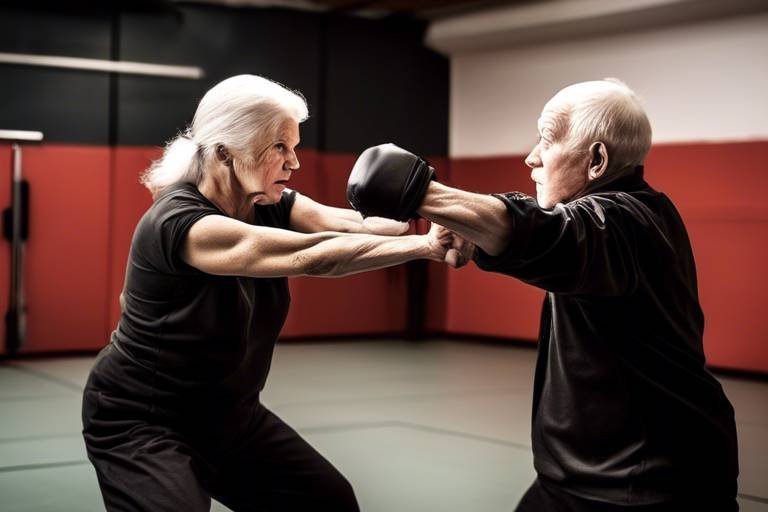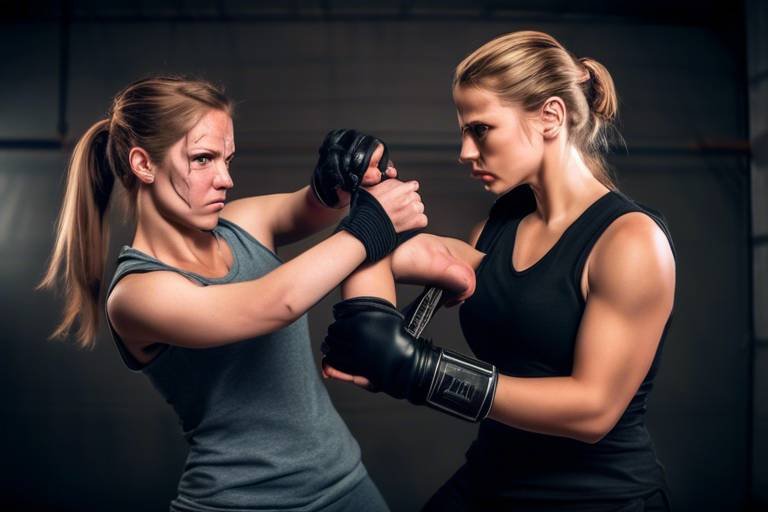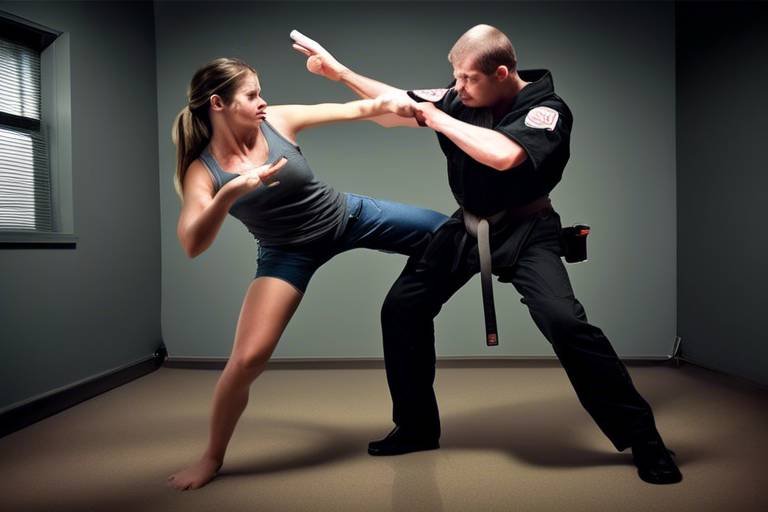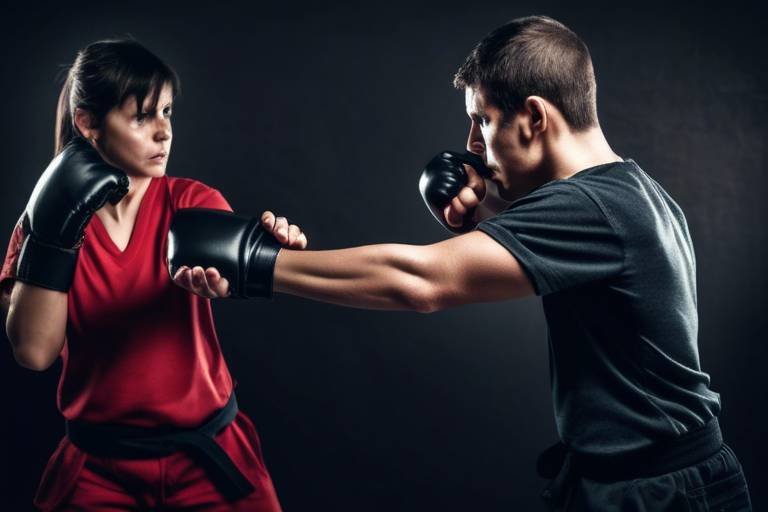How Can Physically Challenged Individuals Master Self-Defense Techniques?
Self-defense is not just a physical skill; it's a vital life skill that empowers individuals to protect themselves in various situations. For physically challenged individuals, the journey to mastering self-defense techniques may seem daunting, but it is entirely achievable with the right mindset, resources, and adaptations. Just like a bird learns to fly despite its initial struggles, those with physical challenges can learn to navigate the world of self-defense by embracing their unique abilities and finding methods that work for them.
Imagine walking into a self-defense class and seeing a diverse group of individuals, each with their own challenges and strengths. This is the beauty of self-defense training; it is inclusive and adaptable. The key lies in understanding that self-defense is a universal right. Everyone, regardless of their physical capabilities, deserves to learn how to protect themselves. This article delves into the various strategies and resources available for physically challenged individuals, ensuring that they can effectively learn and practice self-defense techniques tailored to their needs.
Self-defense is fundamentally about empowerment. It’s about taking control of your safety and well-being. The principles of self-defense are rooted in awareness, avoidance, and action. Awareness involves recognizing potential threats in your environment, avoidance is about steering clear of dangerous situations whenever possible, and action is the last resort when you need to defend yourself. These principles are applicable to everyone, and with the right training, physically challenged individuals can master them just as effectively as anyone else.
Moreover, the essence of self-defense is not solely about physical prowess; it’s about strategy and mental acuity. Think of it like a chess game, where every move counts. A physically challenged individual may not be able to perform a high kick, but they can learn to use their surroundings, their voice, and their wits to navigate potential threats. The goal is to cultivate a mindset that prioritizes safety and confidence, allowing individuals to respond effectively in any situation.
One of the most exciting aspects of self-defense is its adaptability. Many self-defense techniques can be modified to accommodate physical limitations. For instance, techniques that focus on leverage and body mechanics can often be adjusted to suit the individual’s unique abilities. Instead of traditional striking methods, individuals can learn to use their weight and positioning to their advantage. It’s like learning to dance; not every move will fit every dancer, but with creativity and practice, everyone can find their rhythm.
Assistive devices can significantly enhance self-defense capabilities for those with physical challenges. Tools such as canes, walkers, or even self-defense keychains can serve as extensions of one’s body, providing additional leverage and protection. These devices can be integrated into training, allowing individuals to practice techniques that feel natural and effective. Just as a knight wields their sword, a physically challenged individual can learn to wield their assistive device with confidence and skill.
Selecting appropriate equipment is crucial in the journey to mastering self-defense. It’s essential to choose assistive devices that align with personal needs and self-defense goals. For example, a sturdy cane can double as a self-defense tool, while a personal alarm can serve as a deterrent against potential threats. When choosing equipment, consider factors such as:
- Functionality: Does it serve a dual purpose?
- Comfort: Is it easy to use and carry?
- Accessibility: Can it be used in various environments?
Training with assistive devices requires specialized techniques. It’s important to work with qualified instructors who understand how to incorporate these tools into self-defense practices effectively. Training sessions should focus on how to use the device to create distance, block attacks, or even strike when necessary. Just like a musician practices scales to master their instrument, individuals should practice with their devices to build confidence and proficiency.
Mental strength is just as important as physical skills in self-defense. Developing confidence and mental resilience can make a significant difference in high-stress situations. Techniques such as visualization, positive affirmations, and mindfulness can help individuals prepare mentally for potential confrontations. Think of it as training your brain; just as athletes condition their bodies, self-defense practitioners must also condition their minds.
Not all self-defense programs cater to physically challenged individuals, which is why finding the right training program is essential. Look for programs that emphasize inclusivity and adaptability, ensuring that all participants can engage and learn effectively. Many organizations now offer specialized self-defense classes designed specifically for individuals with varying physical abilities, making it easier than ever to find the right fit.
When it comes to training options, both local and online classes have their benefits and drawbacks. Local classes provide hands-on training and immediate feedback, while online classes offer flexibility and accessibility. Here’s a quick comparison:
| Training Option | Benefits | Drawbacks |
|---|---|---|
| Local Classes | Hands-on training, immediate feedback | Limited availability, travel required |
| Online Classes | Flexible schedule, accessible from anywhere | Less personal interaction, potential for distractions |
Finding instructors who understand diverse needs is essential for effective self-defense training. Look for trainers who have experience working with physically challenged individuals and who can adapt techniques accordingly. A good instructor will not only teach you the physical moves but will also encourage you to develop your own strategies and confidence. After all, self-defense is about empowering individuals to take control of their safety.
Q: Can physically challenged individuals really learn self-defense?
A: Absolutely! Self-defense is about strategy, awareness, and adaptability, which can be tailored to fit anyone's unique abilities.
Q: What types of assistive devices can be used in self-defense?
A: Devices such as canes, walkers, and personal alarms can enhance self-defense capabilities and can be effectively integrated into training.
Q: How do I find a suitable self-defense class?
A: Look for programs that emphasize inclusivity and have instructors experienced in working with individuals with physical challenges.
Q: Are online self-defense classes effective?
A: Yes, online classes can be very effective, especially for those who prefer a flexible schedule or have difficulty traveling to a physical location.

Understanding Self-Defense for All
Self-defense is not just a physical skill; it is a fundamental right that belongs to everyone, regardless of their physical capabilities. Imagine walking down the street, feeling vulnerable, and suddenly realizing that you have the power to protect yourself. That feeling of empowerment can be transformative! Self-defense is about more than just fighting back; it's about confidence, awareness, and the ability to respond effectively in challenging situations.
Many people mistakenly believe that self-defense is only for those who are strong or physically fit. This misconception can be as misleading as thinking that only athletes can play sports. In reality, self-defense techniques can be tailored to fit the unique needs of physically challenged individuals. The core principles of self-defense—awareness, avoidance, and assertiveness—are applicable to everyone. It's about using your mind and body in a way that suits your personal strengths.
At its heart, self-defense is about understanding your environment and being prepared. It's like having a mental toolbox filled with various strategies that you can pull from when needed. For physically challenged individuals, this means adapting techniques to leverage their unique abilities. For instance, utilizing mobility devices or even verbal assertiveness can be powerful tools in a self-defense scenario. The key is to recognize that self-defense is not one-size-fits-all; it’s about finding what works best for you.
Moreover, self-defense training can foster a sense of community and belonging. When individuals come together to learn self-defense, they share experiences, challenges, and triumphs. This camaraderie can be incredibly uplifting and motivating, creating a supportive environment where everyone learns from each other. In a world where self-doubt can often creep in, this shared journey can help reinforce the idea that everyone has the right to feel safe and empowered.
In summary, understanding self-defense as a universal right opens the door for physically challenged individuals to embrace their abilities and learn effective techniques for protection. By focusing on adaptability and personal empowerment, we can create a more inclusive approach to self-defense that resonates with all individuals, regardless of their physical challenges.

Adapting Techniques for Physical Challenges
When it comes to self-defense, one size does not fit all. In fact, adapting techniques for physically challenged individuals is not just beneficial; it’s essential. Imagine trying to fit into a pair of shoes that are two sizes too small—uncomfortable, right? Similarly, traditional self-defense techniques may not work for everyone, especially those with unique physical needs. The beauty of self-defense lies in its adaptability; the goal is to empower individuals to protect themselves effectively, regardless of their physical abilities.
To start with, it's important to understand that many self-defense moves can be modified to suit different capabilities. For example, a standard punch might not be feasible for someone with limited arm mobility, but an open-hand strike or a palm heel strike can be just as effective. This is where creativity and resourcefulness come into play. By thinking outside the box, individuals can discover alternative techniques that leverage their strengths.
One effective approach to adapting self-defense techniques is to focus on body mechanics. Understanding how to use your body efficiently can make a significant difference. For instance, individuals with lower limb challenges may find that using their upper body strength for defense—like pushing or striking—can be more effective than attempting to kick. Additionally, techniques that involve using one’s environment can be beneficial. For example, using a wall or a chair for support can provide stability and leverage during an encounter.
Furthermore, it’s crucial to emphasize the importance of situational awareness. Being aware of one’s surroundings can often prevent a confrontation from escalating. This means being alert to potential threats and knowing how to navigate spaces safely. Training can include exercises that enhance observational skills and reaction times, which are invaluable in self-defense scenarios.
Here’s a quick reference table that outlines some common adaptations for specific physical challenges:
| Physical Challenge | Adapted Technique |
|---|---|
| Limited Arm Mobility | Open-hand strikes, elbow strikes |
| Wheelchair Users | Using the wheelchair as a barrier, striking with hands |
| Visual Impairment | Sound cues for awareness, using a cane for defense |
| Hearing Impairment | Visual cues for threat detection, body language reading |
Incorporating assistive devices into self-defense training can also enhance adaptability. For instance, individuals who use canes or walkers can learn to use these tools as extensions of their body, providing both support and a means of defense. The key is to practice regularly and get comfortable with these adaptations, so they become second nature in a stressful situation.
Ultimately, the journey of mastering self-defense techniques tailored to physical challenges is about confidence and empowerment. It’s about recognizing that each individual has unique strengths that can be harnessed in self-defense. The more one practices and adapts, the more proficient they become, transforming perceived limitations into powerful tools for protection.
- Can anyone learn self-defense techniques? Yes! Self-defense is for everyone, and techniques can be adapted to fit individual needs.
- What if I have a specific physical limitation? Many self-defense instructors specialize in adaptive techniques. It’s important to find a program that understands your unique challenges.
- How can I practice self-defense at home? You can practice modified techniques in a safe environment, focusing on body mechanics and situational awareness.

Utilizing Assistive Devices
When it comes to self-defense, the conversation often revolves around physical strength and agility. However, for physically challenged individuals, the narrative can shift dramatically when we introduce assistive devices. These tools are not just gadgets; they can be transformative, enhancing one’s ability to defend themselves effectively. Imagine a world where a wheelchair becomes a shield, or a cane becomes a powerful tool for defense. This is the reality that assistive devices bring to the table.
Assistive devices can take many forms, each tailored to meet the unique needs of an individual. For instance, some may find that a self-defense keychain or a personal alarm is an excellent addition to their arsenal. Others might prefer more specialized equipment, such as modified walking sticks or wheelchair accessories designed specifically for self-defense scenarios. These devices not only empower individuals but also provide peace of mind, knowing they have tools at their disposal to navigate potentially dangerous situations.
What’s essential is understanding how to incorporate these devices into self-defense training. For example, a modified cane can be used to create distance between oneself and an aggressor, while also providing a means of striking if necessary. Training with such devices requires an understanding of balance and control, ensuring that individuals can use them effectively without compromising their safety. It’s about turning what could be perceived as limitations into powerful advantages.
Moreover, the integration of assistive devices into self-defense training fosters a sense of community and support. Training sessions can become collaborative environments where individuals share tips, techniques, and experiences related to their devices. This not only enhances learning but also builds confidence among participants. Self-defense is not just about physical prowess; it's about mental resilience and community support.
In conclusion, utilizing assistive devices in self-defense is not merely an option; it’s a necessity for many. By embracing these tools, physically challenged individuals can redefine their approach to self-defense, transforming challenges into strengths. With the right training and mindset, the potential for self-defense is limitless, allowing everyone to feel empowered and secure.

Choosing the Right Equipment
When it comes to self-defense, the right equipment can make all the difference, especially for physically challenged individuals. It’s not just about having the latest gadgets; it’s about finding tools that truly enhance your ability to protect yourself. Think of it like choosing the right pair of shoes for a marathon—comfort and functionality are key!
First and foremost, consider your specific needs. Are you using a wheelchair, crutches, or other assistive devices? Each situation calls for different types of equipment. For instance, a person using a wheelchair might benefit from a self-defense cane that doubles as a mobility aid. This can provide both support and a means to defend oneself if needed. On the other hand, those who rely on crutches might look for ways to incorporate them into their self-defense techniques, perhaps by learning how to use them as a barrier against an attacker.
Next, let’s talk about personal safety alarms and pepper spray. These are excellent tools for anyone, but especially for those who may feel vulnerable. A personal safety alarm can be easily attached to a keychain or bag, allowing for quick access. When activated, it emits a loud sound that can deter potential attackers and alert others nearby. Similarly, pepper spray can be a powerful tool, but it’s essential to ensure that you can handle it effectively. Practice using it in a controlled environment to gain confidence.
It’s also important to think about self-defense classes that provide equipment as part of the training. Many programs offer gear that is specifically designed for individuals with physical challenges. This can include padded gear for practicing strikes or protective equipment that accommodates various mobility aids. Always ask about the equipment used in classes before signing up. You want to ensure that it aligns with your goals and comfort level.
Lastly, don’t underestimate the power of community. Connecting with others who share similar challenges can provide valuable insights into the best equipment choices. Online forums or local support groups can be a treasure trove of recommendations. You might find someone who has already navigated the waters of finding the right self-defense gear and can point you in the right direction.
In summary, choosing the right equipment for self-defense as a physically challenged individual involves understanding your unique needs, exploring various tools like personal alarms and pepper spray, and seeking out programs that cater to your specific requirements. Remember, the goal is to feel empowered, confident, and ready to handle any situation that may arise.
- What types of self-defense equipment are best for individuals with mobility challenges? Look for multi-functional tools like self-defense canes, personal safety alarms, and pepper spray that can be easily managed alongside mobility aids.
- Can I practice self-defense techniques at home? Absolutely! Many techniques can be adapted for home practice, especially if you have the right equipment and space.
- Are there specific self-defense classes for physically challenged individuals? Yes, many self-defense programs are designed specifically for individuals with diverse abilities. Look for classes that emphasize inclusivity.

Training with Assistive Devices
When it comes to self-defense training for physically challenged individuals, the integration of assistive devices can be a game-changer. These devices not only enhance capability but also offer a sense of empowerment. Imagine a world where the limitations imposed by physical challenges are transformed into opportunities for growth and strength. This is precisely what assistive devices can achieve in the realm of self-defense.
Training with assistive devices requires a different approach than traditional self-defense methods. It's not just about learning to throw a punch or execute a kick; it's about adapting techniques to make them work for you. The key is to focus on the strengths that come with using these devices. For instance, a wheelchair can serve as a shield, while a cane can be transformed into a striking tool. The possibilities are endless when you think creatively!
To effectively train with assistive devices, it's crucial to start with the right mindset. Here are some essential strategies to consider:
- Practice Regularly: Consistency is vital. Just like any skill, the more you practice, the better you become. Schedule regular training sessions to build muscle memory and confidence.
- Focus on Technique: Precision matters more than power. Concentrate on executing techniques correctly rather than relying solely on strength.
- Incorporate Real-World Scenarios: Engage in drills that mimic real-life situations. This will help you understand how to use your assistive device effectively under pressure.
It's also important to seek out instructors who are experienced in teaching self-defense techniques that incorporate assistive devices. A knowledgeable trainer can provide valuable insights and adjustments to ensure that your training is both safe and effective. They can help you identify the best ways to utilize your device in various scenarios, enhancing your overall skill set.
Moreover, consider joining a community or support group focused on self-defense for individuals with disabilities. These groups often share tips, resources, and experiences that can enrich your training journey. Remember, you're not alone in this; there are many others who are navigating similar paths and can offer support and encouragement.
In conclusion, training with assistive devices is not just about overcoming challenges; it's about embracing them. By focusing on your strengths and adapting techniques to your unique needs, you can develop effective self-defense skills that empower you to protect yourself. So, grab your device, find a supportive community, and start your journey toward mastering self-defense today!

Building Mental Resilience
When it comes to self-defense, mental resilience is just as crucial as physical prowess. Imagine standing firm like a mountain amidst a storm; that’s the kind of mental strength we’re aiming for. Building this resilience involves cultivating a mindset that embraces challenges, learns from failures, and remains unwavering in the face of adversity. For physically challenged individuals, the journey to mastering self-defense techniques can be daunting, but with the right mental tools, they can transform obstacles into stepping stones.
First and foremost, it’s essential to acknowledge that everyone faces unique challenges. Acknowledging these challenges is the first step toward overcoming them. By embracing one’s individuality, individuals can create a personalized approach to self-defense that resonates with their experiences. This can be akin to customizing a recipe to suit your taste; it’s all about finding what works best for you. Engaging in self-reflection can help in identifying personal strengths and areas for improvement, which is vital in developing a robust mental framework.
Moreover, visualization techniques can play a significant role in building mental resilience. Picture this: before stepping onto the mat for a self-defense class, you take a moment to visualize yourself executing a technique flawlessly. This mental rehearsal not only boosts confidence but also prepares the mind for real-life scenarios. It’s like playing a video game in your head; the more you practice, the more skilled you become. Incorporating visualization into training routines can enhance performance and instill a sense of control over one’s abilities.
Another powerful tool in fostering mental resilience is the practice of positive self-talk. The way we speak to ourselves can shape our reality. Instead of dwelling on limitations, focus on affirmations that promote strength and capability. For instance, replace thoughts like “I can’t do this” with “I am capable of learning and adapting.” This shift in mindset can be transformative, creating a more empowering narrative that encourages perseverance. Just as a seed needs nurturing to grow, our minds need positive reinforcement to flourish.
Finally, surrounding oneself with a supportive community can significantly bolster mental resilience. Engaging with others who share similar experiences can provide a sense of belonging and understanding. Whether through local support groups or online forums, connecting with fellow learners can foster motivation and encouragement. It’s like being part of a team where everyone cheers each other on, making the journey of learning self-defense feel less isolating and more collaborative.
In summary, building mental resilience is a multifaceted process that involves self-awareness, visualization, positive self-talk, and community support. By embracing these strategies, physically challenged individuals can cultivate the mental fortitude necessary to navigate the world of self-defense with confidence and determination. Remember, every small step taken toward mental resilience is a leap toward personal empowerment.
- What is mental resilience? Mental resilience is the ability to adapt to challenges and bounce back from setbacks, maintaining a positive mindset.
- How can visualization help in self-defense? Visualization helps prepare the mind for real-life scenarios, boosting confidence and enhancing performance.
- Why is positive self-talk important? Positive self-talk reinforces a capability mindset, encouraging individuals to overcome limitations and embrace their strengths.
- How can I find a supportive community? Look for local support groups, online forums, or social media communities focused on self-defense and inclusivity.

Finding the Right Training Programs
When it comes to mastering self-defense techniques, finding the right training program is crucial, especially for physically challenged individuals. Not all self-defense courses are created equal, and many traditional programs may not accommodate specific needs. It’s essential to seek out programs that prioritize inclusivity and adaptability to ensure that everyone can learn effective self-defense strategies. But how do you navigate through the myriad of options available? Let’s break it down.
First and foremost, it's important to look for programs that explicitly state their commitment to inclusivity. This means they should have instructors trained in adaptive techniques and a curriculum that considers various physical abilities. Many self-defense schools are now recognizing the importance of catering to diverse needs, and they offer specialized classes designed for individuals with physical challenges. These programs often incorporate modified techniques that enhance the ability to defend oneself while ensuring safety and comfort.
Another key factor to consider is the training environment. A supportive and understanding atmosphere can make a world of difference in the learning experience. When visiting potential training centers, pay attention to how instructors interact with students. Are they patient and encouraging? Do they demonstrate a clear understanding of different physical limitations? A positive environment fosters confidence and encourages individuals to push their boundaries.
In addition to looking for local training programs, don’t overlook online options. Online self-defense courses can provide flexibility and accessibility for those who may have difficulty attending in-person classes. These programs can range from video tutorials to live virtual classes, allowing participants to learn at their own pace. However, it's vital to ensure that the online course is tailored to the needs of physically challenged individuals. Look for programs that offer personalized feedback or have interactive components that allow for questions and clarifications.
To help you in your search, here are some important criteria to consider when evaluating training programs:
- Instructor Qualifications: Ensure that instructors have experience working with diverse physical abilities and understand the principles of adaptive self-defense.
- Curriculum Content: Review the curriculum to ensure it includes techniques that cater to various physical challenges.
- Student Testimonials: Look for reviews or testimonials from other physically challenged individuals who have participated in the program.
- Trial Classes: If possible, attend a trial class to gauge the suitability of the program for your needs.
Ultimately, the right training program should empower individuals to feel confident and capable in their ability to defend themselves. It’s about finding a supportive community that understands unique challenges and provides effective solutions. With the right guidance and resources, physically challenged individuals can master self-defense techniques that not only enhance their safety but also boost their overall confidence.
Q: Are there self-defense classes specifically for physically challenged individuals?
A: Yes, many self-defense programs are now designed specifically for individuals with physical challenges, focusing on adaptive techniques and inclusive training environments.
Q: Can I learn self-defense online?
A: Absolutely! There are numerous online self-defense courses available that cater to diverse needs, allowing you to learn at your own pace from the comfort of your home.
Q: How do I find qualified instructors?
A: Look for instructors with experience in adaptive self-defense. Check their credentials, read reviews, and don’t hesitate to ask about their experience working with individuals with physical challenges.

Local vs. Online Training Options
When it comes to mastering self-defense techniques, individuals often find themselves at a crossroads: should they pursue local training or opt for the convenience of online classes? Each option has its unique set of advantages and potential drawbacks, especially for those with physical challenges. Let's dive into the details to help you make an informed choice that best suits your needs.
Local training offers a hands-on experience that can be incredibly beneficial. Being in a physical class allows for real-time feedback from instructors, which is crucial when adapting techniques to accommodate physical limitations. Moreover, the camaraderie and support from fellow students can foster a sense of community, making the learning process more engaging and less intimidating. Instructors can also tailor their teaching methods on-the-spot, ensuring that everyone feels included and capable of learning.
On the flip side, online training options have surged in popularity, especially in recent years. They provide unparalleled flexibility, allowing individuals to learn at their own pace and schedule. This can be particularly advantageous for those with mobility challenges or those who may feel uncomfortable in a traditional classroom setting. Online platforms often feature a wide variety of courses, from basic self-defense to advanced techniques, which means you can choose a program that aligns perfectly with your personal goals.
However, it's essential to consider the potential downsides of online training. Without the immediate presence of an instructor, feedback may be delayed or less personalized. This can make it challenging for individuals to grasp complex techniques or adapt them to their unique circumstances. Additionally, the lack of in-person interaction may lead to feelings of isolation, making it harder for some to stay motivated.
To help you weigh your options, here’s a quick comparison of local vs. online training:
| Aspect | Local Training | Online Training |
|---|---|---|
| Feedback | Immediate and personalized | Delayed and less personalized |
| Flexibility | Fixed schedule | Learn at your own pace |
| Community | In-person support | Online interaction and forums |
| Accessibility | May require travel | Accessible from anywhere |
Ultimately, the decision between local and online training comes down to personal preference and circumstances. Some individuals may thrive in a local environment, while others may find online classes to be more accommodating to their physical needs. The most important factor is to choose a program that makes you feel empowered and confident in your self-defense abilities.
As you explore your options, remember that the journey to mastering self-defense is uniquely yours. Whether you decide to hit the mats in a local dojo or tune in to an online class from the comfort of your home, the key is to stay committed and enjoy the learning process. After all, self-defense is not just about physical techniques; it's about building confidence, resilience, and a sense of safety in your everyday life.
- Can physically challenged individuals really learn self-defense? Absolutely! Self-defense is for everyone, and there are numerous techniques tailored specifically for various physical abilities.
- What should I look for in a self-defense instructor? Look for someone who has experience working with individuals with diverse needs and can adapt techniques accordingly.
- Are online self-defense classes effective? Yes, they can be very effective, especially if the program includes interactive elements and personalized feedback.
- How can I stay motivated during online training? Set personal goals, engage with online communities, and track your progress to keep your motivation high.

Qualified Instructors for Diverse Needs
Finding the right instructor is crucial for anyone looking to master self-defense, but it's especially vital for physically challenged individuals. Why? Because not all instructors possess the knowledge or sensitivity required to teach self-defense techniques that cater to diverse needs. A qualified instructor not only understands the mechanics of self-defense but also appreciates the unique challenges faced by individuals with physical limitations. They should be able to modify techniques and create a supportive environment that fosters learning and confidence.
When searching for an instructor, consider the following key factors:
- Experience with Diverse Populations: Look for instructors who have a track record of working with individuals of varying abilities. Their experience can make a significant difference in how they approach teaching.
- Certification and Training: Ensure that the instructor has relevant certifications in self-defense as well as specialized training in adaptive techniques. This ensures they are well-equipped to teach effectively.
- Empathy and Communication Skills: A good instructor should possess strong interpersonal skills, allowing them to communicate effectively and empathetically with students. This helps in building trust and understanding.
Moreover, it’s beneficial to conduct a preliminary meeting or trial class with potential instructors. This allows you to gauge their teaching style and see if it aligns with your learning preferences. Ask questions about their approach to teaching self-defense to physically challenged individuals. For instance, how do they modify techniques? What kind of supportive environment do they create? These inquiries can provide valuable insight into their methods and philosophy.
Additionally, consider the instructor's ability to create a community. Self-defense is not just about learning techniques; it’s about building confidence and forming connections with others who share similar experiences. A supportive community can enhance the learning experience, making it more enjoyable and effective. Look for programs that encourage group activities, peer support, and social interactions, as these elements can significantly enrich your training journey.
In summary, the right instructor can make all the difference in your self-defense training. They should be knowledgeable, adaptable, and empathetic, ensuring that you feel empowered and capable. So, take your time in finding a qualified instructor who truly understands your needs, and embark on your self-defense journey with confidence!
Q1: How do I find instructors who specialize in teaching self-defense to physically challenged individuals?
A1: A great start is to search online for local self-defense programs that advertise inclusivity. You can also check community centers, disability organizations, or martial arts schools that emphasize adaptive training.
Q2: Are there specific self-defense techniques that are better for individuals with physical challenges?
A2: Yes! Techniques that focus on leverage, awareness, and quick escapes are often more effective. Instructors can help modify traditional techniques to suit individual abilities.
Q3: What should I expect in a trial class with a self-defense instructor?
A3: Expect to discuss your goals and any physical limitations you may have. The instructor should demonstrate how they adapt techniques and provide a supportive atmosphere for learning.
Frequently Asked Questions
- Can physically challenged individuals really learn self-defense?
Absolutely! Self-defense is a universal right, and everyone, regardless of their physical abilities, can learn techniques tailored to their unique needs. With the right approach and adaptations, self-defense can be effective and empowering for physically challenged individuals.
- How can self-defense techniques be adapted for physical challenges?
Many traditional self-defense moves can be modified to accommodate various physical limitations. This might involve simplifying movements, using leverage instead of strength, or focusing on techniques that utilize an individual’s unique strengths. The key is to find adaptations that work best for each person.
- What role do assistive devices play in self-defense training?
Assistive devices can significantly enhance self-defense capabilities. They can provide added support, improve mobility, or serve as tools to help defend oneself. Incorporating these devices into training not only boosts confidence but also ensures that individuals can effectively protect themselves.
- How do I choose the right assistive equipment for self-defense?
Selecting the right equipment is crucial. Consider your specific needs, physical abilities, and the types of self-defense techniques you want to learn. Consulting with instructors who specialize in adaptive self-defense can also provide valuable insights into the best options available.
- Are there specific training programs for physically challenged individuals?
Yes, there are training programs specifically designed for physically challenged individuals. These programs focus on inclusivity and adaptability, ensuring that all participants can learn effective self-defense techniques. Researching local options or online courses can help you find the right fit for your needs.
- What should I look for in a self-defense instructor?
When searching for a self-defense instructor, look for someone who has experience working with diverse needs and understands the challenges faced by physically challenged individuals. An instructor who is patient, knowledgeable, and adaptable will make a significant difference in your learning experience.
- Are online training options effective for learning self-defense?
Online training can be a convenient and effective option for learning self-defense. It allows individuals to train at their own pace and in a comfortable environment. However, it's important to ensure that the program is tailored to your needs and includes guidance on adapting techniques for physical challenges.
- How can I build mental resilience while learning self-defense?
Building mental resilience is just as important as physical training. Techniques such as visualization, positive affirmations, and setting achievable goals can help boost confidence. Surrounding yourself with supportive peers and instructors can also create a positive learning environment that fosters mental strength.

